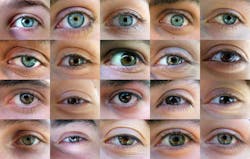Like many vendors in the Li-Fi business, France’s Oledcomm believes there is a strong future for the use of lasers, which will provide exponentially faster data transmission rates than do today’s LED-based Li-Fi systems. But there’s an eye-opening reason why LEDs will stay on the roadmap.
“In some use cases, lasers have an issue which is eye safety,” Oledcomm co-CEO Benjamin Azoulay told LEDs Magazine. “I’m not sure you’d use lasers in schools, for example, because lasers will never have the eye safety that is required for this type of operation. So I think in the future there will be both solutions, lasers on one side and LEDs also, depending on the type of application.”
As LEDs has reported many times, speedy lasers could finally usher in the sort of mass adoption that has so far eluded Li-Fi, the Wi-Fi–like technology that uses modulated light from LED chips, rather than Wi-Fi’s radio frequencies, to transmit data and the internet.
Vélizy-Villacoublay–based Oledcomm is among those companies that are believers in lasers. Azoulay and fellow co-CEO Pierre-Jean Beylier made that clear to LEDs when we interviewed them recently.
But the well-known retinal damage that laser exposure can cause should assure a continued place for LEDs, they said.
That is particularly true in the infrared spectrum, which Oledcomm uses in its LED Li-Fi offering, because it is faster than visible-light LED.
Referring specifically to laser Li-Fi, Azoulay noted, “Infrared is even more dangerous than visible light. When you [face glare from] visible light, you close your eyes. But with infrared, you don’t close your eyes. It’s really dangerous. You cannot protect yourself. You don’t see it.”
Some laser specialists, like Santa Barbara, Calif.–based Kyocera SLD Laser note that lasers can be engineered to be safe to the eye.
But whether or not you modify the lasers, there are other reasons to keep LED in the Li-Fi mix.
“In addition to the eye issue, you have cost issues,” Oledcomm co-CEO Beylier said. “In most cases [lasers are] more expensive than LED. So, depending on the use case you are working on, it may be beyond what makes sense financially.”
We asked: Any other limitations to laser Li-Fi?
“In general, it also requires very precise pointing,” Beylier noted. “There are use cases where things are moving, where things may not always happen at the same place, and you want to have flexibility in pointing. So there are benefits with lasers, of course, but there are also inconveniences that in some case means that LEDs are a better option.”
LEDs will continue to keep an eye on developments. Please pardon the pun.
MARK HALPER is a contributing editor for LEDs Magazine, and an energy, technology, and business journalist ([email protected]).
For up-to-the-minute LED and SSL updates, follow us on Twitter. You’ll find curated content and commentary, as well as information on industry events, webcasts, and surveys on our LinkedIn page and our Facebook page.






